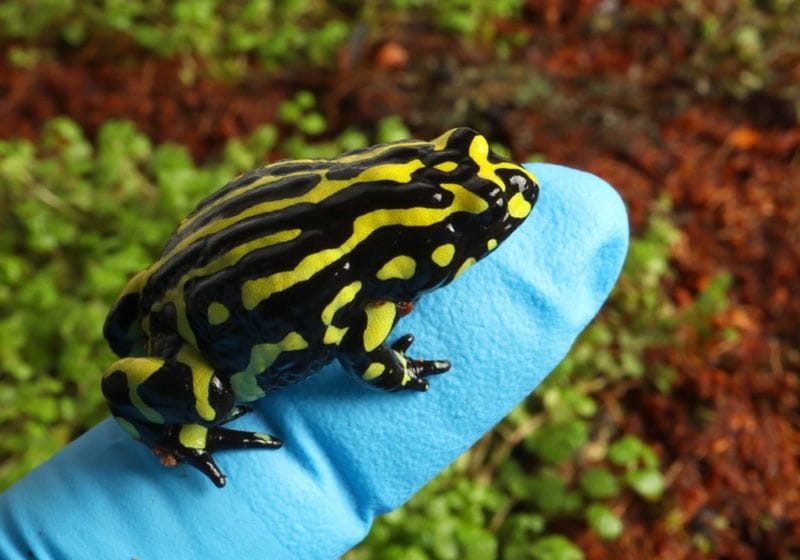Scientists Leverage Genomics to Save Endangered Frogs from a Deadly Fungus New

Estimated reading time: 6 minutes
The southern corroboree frog is one of Australia’s iconic species, but Chytridiomycosis has decimated its wild populations.
Image credit:Corey Doughty, University of Melbourne
You might enjoy HBO’s The Last of Us, but for frogs, the fungi-triggered zombie apocalypse show hits far too close to home. Since the 1980s, a deadly fungal disease has been spreading through amphibian populations across the globe, causing mass mortality.
For years, the mysterious deaths had researchers at a loss, but in 1998 they identified the disease: chytridiomycosis or simply ‘chytrid’ caused by the Batrachochytrium dendrobatidis fungus.1 Originating somewhere in Asia, it was introduced to Australia and the Americas by accident and spread rapidly through native frog populations. Once infected, frogs slowly suffocate as the fungus grows over their skin. In some species, mortality rates are as high as 100 percent.
“Chytrid is the most impactful disease ever recorded in wildlife, and that’s because it’s caused over 90 amphibians to become extinct, and at least 500 are known to be threatened,” said Tiffany Koscha conservation genomics researcher at the University of Melbourne. “It’s a continuing problem worldwide.”
Tiny Frog, Huge Genome
Kosch, who has always loved frogs, wanted solve the chytrid fungus problem since she first heard about it. During her graduate studies, she worked on mapping the distribution of chytrid in Peru, where it has affected around 80 species of frogs.
While she found the project rewarding, she soon became frustrated with the lack of solutions: Frogs kept dying, and there was little investment in proactive conservation efforts. “That’s why I was very interested in coming to Australia to work with the corroboree frogs, because there’s a lot of investment in returning them to the wild,” Kosch explained.
In Australia, chytrid has had a particularly devastating impact on wild frog populations since it was introduced, and none more so than the Southern corroboree frog, Pseudophryne corroboree. The tiny, iconic species only lives in a limited subalpine range of New South Wales, where its populations have been decimated by the disease. The species is now functionally extinct, and ongoing captive breeding programs have been unsuccessful at establishing new populations despite multiple attempts to reintroduce them into the wild.
At the University of Melbourne, Tiffany Kosch and her team are using genome sequencing technology to create better breeding programs for the functionally extinct Southern corroboree frog.
Tiffany Kosch, University of Melbourne
Kosch is determined to explore ways to protect the Southern corroboree frog from chytrid, and genomics seemed like the best avenue to give the frogs a fighting chance.2 Together with experts from Rockefeller University’s Vertebrate Genomes ProjectKosch and her team at the University of Melbourne sequenced the species’ genome, which the authors say is the highest-quality frog genome published to date.3
The team didn’t realize that the Southern corroboree frog genome had a few plot twists in store, the first of which was its impressive size—three times the size of the human genome. “Initially, even the size of the genome was quite a surprise,” said Kosch. “We did some early estimates, and we thought it was only going to be six gigabases, but it ended up being about nine. Some of their relatives have much smaller genomes.”
Establishing Resistance: Breeding Programs Versus Gene Editing
Luckily, through the breeding program, they were able to identify several ‘Ellies’: Like the main character of The Last of Us, these individuals are immune to the fungus. The next question was whether or not that immunity was heritable. To identify if there were genetic variants that are linked to resistance, Kosch and her colleagues performed a genome-wide association study. “We’ve looked at within-species variation in chytrid susceptibility, and we found variation, and we found that it’s heritable at about 20 percent and a polygenic trait, so that we can breed the frogs for increased resistance,” Kosch explained.
While it seems simple enough to breed a population of immune frogs, Kosch said it may not be an effective solution. “We just don’t know if it’s going to be enough to achieve self-sustaining populations, which is our goal, because some species have actually evolved resistance and recovered in the wild, and that didn’t happen with the corroboree frogs,” she remarked. “It could be because they are not capable of evolving enough resistance.”
A captive-bred Southern corroboree frog has its armpits swabbed to test for evidence of chytrid fungus.
Corey Doughty, University of Melbourne
To cover all their bases, the team is also investigating the possibility of using gene editing technology to create lineages of resistant frogs—for example, by inserting beneficial gene variants into single-celled frog embryos using CRISPR-Cas9. Kosch has already initiated international collaborations with experts like Jacques Roberta microbiologist and immunologist at the University of Rochester who has extensive experience in gene editing and working with amphibians.
However, identifying a gene that has a high impact on the frogs’ susceptibility to the fungus is much like searching for a needle in a haystack. Luckily, Kosch said, several frog species in Australia, including the Common Eastern frogletwhose distribution overlaps with the Southern corroboree frog, exhibit strong resistance to chytrid.4 “I’ve just sequenced the genome of that one as well, so I’m going to be doing some comparative work to look for the genes (responsible for resistance),” Kosch said.
A Stem Cell Biobank on the Horizon
In parallel, members of Kosch’s team are also surveying public attitudes to genetic engineering in conservation projects, as well as working with indigenous communities to ensure the success of any reintroductions of captive-bred frogs. So far, she said, the community has been supportive of their work: “The use of genetic engineering and conservation is more or less unprecedented. We don’t know how it’s going to proceed, but we’re hoping, if we start early to foster positive public attitudes, that it won’t be an issue.”
One of Kosch’s related projects involves working with museums to collect stored tissues and generate stem cell biobanks for all of Australia’s threatened amphibians. According to Kosch, it will be much easier to screen the candidate genes they identified in their genome-wide association study in cell culture rather than in live animals. “This will serve as a genetic resource so that we don’t lose the genetics of these species in the future, so we can actually clone them someday, if those animals don’t breed,” Kosch added.
If successful, Kosch believes her work with the southern corroboree frog could help her team and other researchers explore the genetics of disease resistance in other amphibians and inform conservation strategies for the approximately 200 species that are currently reliant on captive breeding programs.5 “What we’re hoping is that the work in (the southern corroboree frog) would be a proof-of-concept for other amphibians,” said Kosch. “This approach could also work for other wildlife threatened by intractable threats, including climate change.”



